Cause of 2021 songbird mortality event still unknown
BY DAVID SINGLETON STAFF WRITER Jan 9, 2023
It baffled scientists then, and it remains a puzzle today.
Almost two years after the first reported cases of a mysterious ailment killed and sickened songbirds in Pennsylvania and elsewhere, researchers are still uncertain of the cause.
...
“We went through a series of diagnostic tests and it was inconclusive. The testing failed to reveal a clear cause for this mortality event,” Hackett said. “So we are not quite sure what happened.”
The Game Commission said previously that several pathogens had been ruled out, including salmonella, chlamydia, avian influenza virus, West Nile virus, Newcastle disease virus, herpesviruses, poxviruses and trichomoniasis parasites.
...
Bonnie Yuscavage, president of the Greater Wyoming Valley Audubon Society, said while she is encouraged the songbird illness did not return in 2022, it is nonetheless concerning that the cause is still unknown.
...
https://www.bradfordera.com/sports/o...10ad342ec.html
Announcement
Collapse
No announcement yet.
US - Wildlife officials investigating mysterious bird illness in several states - June 11, 2021+
Collapse
X
-
As the East's Songbird Epidemic Fades, the Cause Remains Unknown
Affected states recommended taking down feeders during the disease outbreak, but now all say feeders can go back up.
By Lauren Leffer
Reporter, Audubon magazine
September 22, 2021
The mysterious outbreak that caused widespread songbird death and sickness across the eastern and midwestern U.S., statewide feeder removal recommendations, and public concern appears to have subsided.
From late April through July, reports of disoriented and dead songbirds with swollen eyes proliferated across almost a dozen states. Most accounts were of juvenile birds, particularly American Robins, Blue Jays, Common Grackles, and European Starlings—common visitors to backyards and bird feeders. Sick birds were officially documented in Virginia, Maryland, Delaware, New Jersey, Pennsylvania, West Virginia, Kentucky, Ohio, Indiana, and the District of Columbia. Agencies in each of the states recommended taking down feeders and draining birdbaths as a precaution against social spread.
As of September 10, all states have lifted those advisories. The last agencies to do so were the Ohio and Indiana Departments of Natural Resources. The change came in response to a steep decrease in the number of reports of sick and dead birds. But even as active case numbers fall, the cause of the illness remains a mystery.
...
Leave a comment:
-
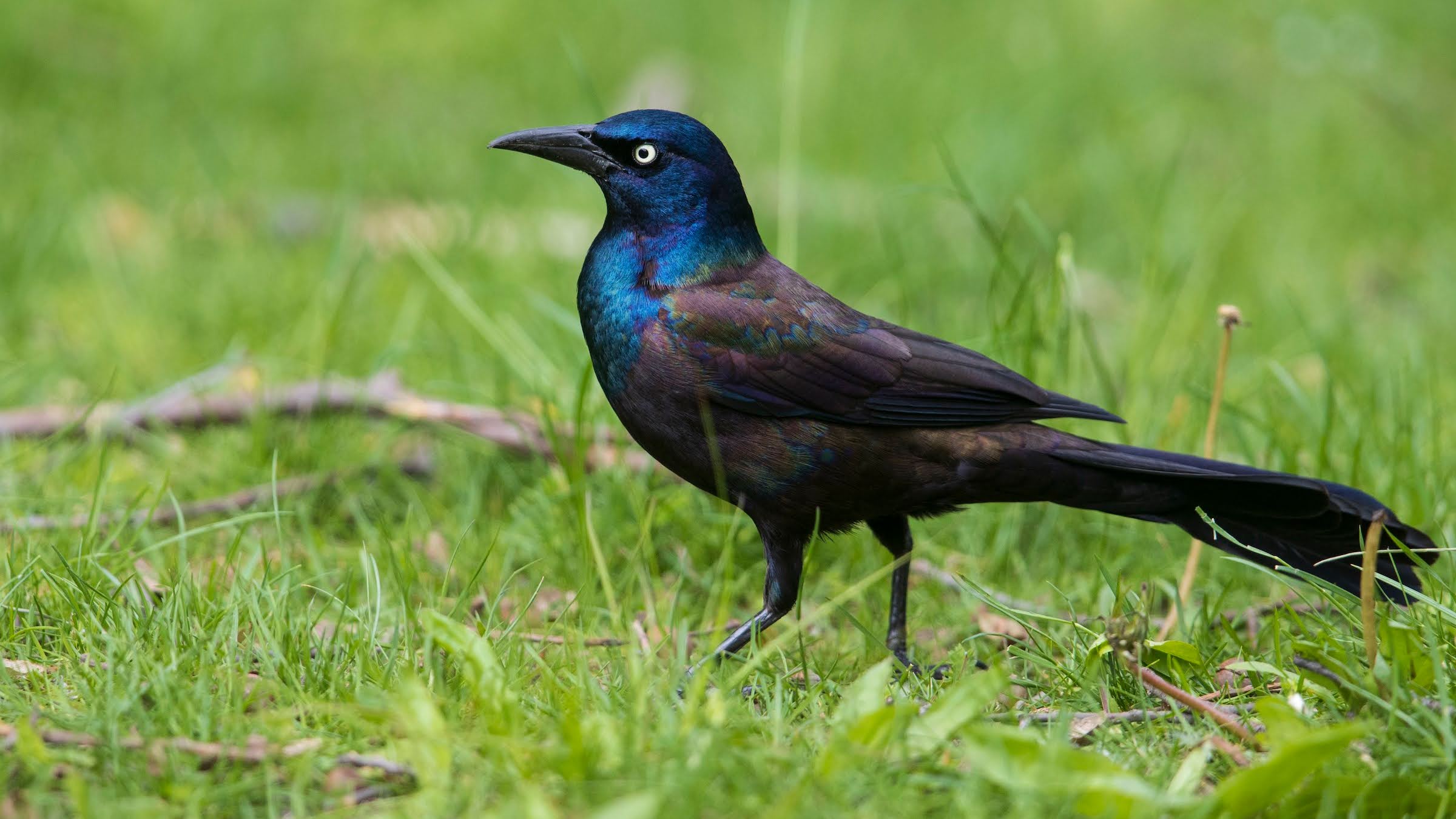 Updated on September 17, 2021. All states affected by the mysterious bird illness of summer 2021 have lifted their do-not-feed recommendations (see below for links). No cause has yet been determined, but cases are no longer being reported. Links to state-by-state information are compiled at the end
Updated on September 17, 2021. All states affected by the mysterious bird illness of summer 2021 have lifted their do-not-feed recommendations (see below for links). No cause has yet been determined, but cases are no longer being reported. Links to state-by-state information are compiled at the end
Statement on Unidentified Songbird Illness Reported from Eastern U.S.
July 14, 2021 Updated on August 23, 2021.
A joint statement of the Cornell Lab of Ornithology and the Cornell University College of Veterinary Medicine.
Many people are concerned about the emergence of a new illness causing crusty eyes, tremors, and paralysis among songbirds in several eastern states including Virginia, Maryland, Delaware, New Jersey, Pennsylvania, West Virginia, Kentucky, Ohio, Indiana, and District of Columbia. This illness and the uncertainty around it are upsetting, and we share your concern.
The Cornell Lab of Ornithology does not have experts studying the situation. We have prepared this statement with the help of the Cornell University College of Veterinary Medicine to summarize the state of knowledge of experts in state and federal agencies who are working to understand this event. For a detailed summary of the situation, please see this statement from the U.S. Geological Survey.
The main points to know- Please follow your own state’s guidelines on whether to take down bird feeders. Find your state agency here.
- Although little is known yet about the cause, as of mid-July, it appears that the incidence of the illness may be waning.
- No human health or domestic livestock/poultry issues have been reported.
- The illness is not caused by any of the major known bird diseases such as West Nile, salmonella, avian influenza, House Finch eye disease, Trichomonas parasites, etc.
- The species most frequently affected are fledgling (juvenile) Blue Jays, Common Grackles, European Starlings, and American Robins, along with a few other species. Symptoms include crusty eyes and neurological signs such as tremors or partial paralysis.
- We don’t yet know if the illness is caused by a disease organism (i.e., virus, bacteria, or parasite), or if it’s the result of a toxic substance in the landscape.
- If it’s a disease, we don’t know how it’s transmitted. It might be directly transmissible from bird to bird (like a cold or the flu), or might require a vector (such as with malaria, where a mosquito transmits the illness)...
Leave a comment:
-
NC Wildlife Resources Commission
August 10 at 6:53 AM ·
In late May, biologists began to receive reports of sick and dying songbirds in Washington D.C., Maryland, Virginia, West Virginia, and Kentucky. Infected birds appear to be lethargic and/or have crusty or swollen eyes. More recently additional states have been included, and our agency has begun receiving reports of sick and dying birds which may be due to the new disease.
To reduce the spread of this outbreak, we recommend:
- Remove bird feeders entirely until the threat subsides. At this time natural food sources are abundant.
- Clean feeders and bird baths FREQUENTLY with a 10% bleach solution. Rinse with water and allow to dry before refilling.
- Consider native plantings as a healthier, safer alternative to feeders. You can find a list of plants native to your area from the Audubon Society.
- Avoid handling sick or dead birds. If moving a bird is necessary, use gloves or an inverted plastic bag to prevent direct contact with it.
- Keep pets (including pet birds) away from sick or dead wild birds.
If you find dead birds, email hwi@ncwildlife.org with a photo of the dead bird(s), including date found and location. Report sick birds to a licensed rehabilitator (bit.ly/3jKb5UI
).
https://www.facebook.com/ncwildlifer.../?__tn__=-UC*F
---------------------------------------------------------------------------------------------------------------------------
CT bird deaths concerns expand: Ducks, raptors, terns, even chickens being tested for mystery disease
Ed Stannard
Aug. 11, 2021
Updated: Aug. 11, 2021 4:17 p.m.
The variety of birds that are dying in mysterious ways is growing, though it is unknown whether whatever has been causing birds to die is spreading to other species.
...
On Tuesday, a roseate tern was found with neurological symptoms at Sandy Point in West Haven, Patrick Comins, executive director of the Connecticut Audubon Society, said Wednesday. “There are a lot of things that can cause that, blue-green algae or red tide.”
...
Within the last two weeks, several swans and ducks were found dead in Great Meadows Marsh in Stratford, Comins said. Boom cannons were brought in to scare away other waterfowl. “They were kind of floating face down in the water and that’s usually how botulism plays out,” he said. But that hasn’t been determined.
During an online webinar Wednesday, Jenny Dickson, director of DEEP’s Wildlife Division, said terns and raptors have been reported with symptoms that come with the mystery syndrome: swollen and crusty eyes, neurological problems such as an inability to stand.
And Brian Evans, migratory bird ecologist at the Smithsonian Migratory Bird Center, located at the National Zoo in Washington, D.C., said that while reports are “really, really scant,” chickens have been reported with symptoms.
All these add to the growing list of songbirds, woodpeckers and hummingbirds that are being tested at the UConn lab in Storrs.
...
https://www.registercitizen.com/news...s-16380491.php
Leave a comment:
-
3 dead birds in Connecticut show similar symptoms to dead birds elsewhere so “please don’t feed” recommendation remains
...
August 2, 2021 — Please don’t put your bird feeders back up yet.
The state of Connecticut reported that it has tested three dead birds, and that preliminary results suggest that the “cases match” what’s been seen in dead birds suffering from this condition elsewhere.
In other words, there’s some evidence that the condition that is killing birds in southern, mid-Atlantic, and mid-western states has reached Connecticut.
The condition itself is still a mystery, which is the reason it is so difficult to confirm. Nearly all known bird diseases have been tested for and ruled out in Connecticut and elsewhere.
...
 August 2, 2021 — Please don’t put your bird feeders back up yet. The state of Connecticut reported that it has tested three dead birds, and that preliminary results suggest that the “cases match” what’s been seen in dead birds suffering from this condition elsewhere. In other words, there’s some evidence that the condition that is killing birds in southern, mid-Atlantic, and mid-western states has reached Connecticut.
August 2, 2021 — Please don’t put your bird feeders back up yet. The state of Connecticut reported that it has tested three dead birds, and that preliminary results suggest that the “cases match” what’s been seen in dead birds suffering from this condition elsewhere. In other words, there’s some evidence that the condition that is killing birds in southern, mid-Atlantic, and mid-western states has reached Connecticut.
--------------------------------------------------------------------------------------
Connecticut
Department of Energy and Environmental Protection
...
Mysterious Bird Illness
...
Update, August 2, 2021: Work continues to identify the cause of the emerging illness affecting songbirds across the eastern United States. Although some known bird diseases have been ruled out, the cause remains unknown. While cases seem to be dropping in some states, we have not observed a similar trend in Connecticut. The DEEP Wildlife Division has received hundreds of reports of dead birds during July, most of which were not suitable for analysis. Three birds exhibiting symptoms consistent with the regional illness have been submitted to the Connecticut Veterinary Medical Diagnostic Laboratory at UConn for testing. All three tested negative for avian influenza, and other analyses are still pending. Preliminary results suggest that these cases match what has been reported in the mid-Atlantic and Midwest regions.
The Wildlife Division would like to thank the public for their cooperation in removing bird feeders and bird baths, and thank all who have taken the time to submit reports of dead birds over the past several weeks. At this time, we do not have data to support a change in our recommendation on bird feeding. Please continue to refrain from feeding birds, including hummingbirds, and temporarily remove bird baths. The public is reminded that songbirds and hummingbirds have an abundant supply of natural sources of insects, seeds, fruit, nectar, and water at this time of year. In order to mitigate any potential disease spread, any activity that results in the congregation of birds (such as feeding birds or filling bird baths) should be stopped while more information is collected. You can continue to report sightings of dead birds or birds displaying signs of illness using our online form.
DEEP biologists continue to work with other state agencies, universities, and laboratories to coordinate efforts and share information. We are also working with licensed wildlife rehabilitators to identify cases and collect samples. Stay tuned to this webpage for updates and also follow the USGS National Wildlife Health Center at https://www.usgs.gov/centers/nwhc.Thank you for helping to keep our songbirds safe.
-----------------------------------------------------------------------------------
Updates on Mysterious Bird Illness
Update, August 6, 2021: The DEEP Wildlife Division continues to collect reports and submit samples for testing as the search for the cause of the songbird mortality event continues. Two more birds (a European starling and a chipping sparrow) were submitted to the Connecticut Veterinary Medical Diagnostic Laboratory (CVMDL) this week. Final results for the three cases submitted previously are still pending.
While we have received reports of dead birds, that is not necessarily unusual for this time of year. As young, inexperienced birds leave the nest, they frequently die from impacts with windows or are killed by housecats and other predators. Birds, especially fledglings, are also susceptible to known diseases like West Nile virus and avian influenza. The birds submitted to CVMDL for testing have been consistent with symptoms of the mystery die-off reported in other states.
There has been a lot of speculation regarding what is causing this die-off. One initial thought was that the emergence of the Brood X cicadas and possible bioaccumulated toxins may have played a role since the early geographic extent of the disease was similar to the range of the cicada emergence. Expansion of the reported geographic extent of the songbird die off and lack of detection of toxic agents to date make this unlikely. Wildlife health labs are actively testing many hypotheses, looking for both toxins and pathogens, but have not found a causative agent. The cause of this illness remains unknown, but many typical avian illnesses have been consistently ruled out.
At this time, we do not have data to support a change in our recommendation on bird feeding. Please continue to refrain from feeding birds, including hummingbirds, and temporarily remove bird baths. Thank you for helping to keep our songbirds safe.
...
Leave a comment:
-
LUNSFORD COLUMN: Songbirds have grown silent
4 hrs ago
...
Brad Bumgardner, executive director of the Indiana Audubon Society, says his office has been “bombarded” by questions about the bird dilemma and says, “Without more testing, it’s simply speculation, but it does appear to be spreading with birds, and beyond feeder birds.”
Bumgardner says the illness is a real, not imagined, cause for alarm. “My biggest concern is if we start documenting it in larger birds, such as hawks and owls. These birds have lower breeding rates, just one or two eggs a year, so a hit to their populations will take longer to rebound,” he adds.
...
Bumgardner has strong doubts about any connection to cicadas. “An article came out that suggested a correlation between the timing with cicadas, but a correlation is not causation. Most folks don’t understand the difference between the two, leading people, and the media, to try to link them. We have no evidence that the cicadas are involved. There is data that suggests it was documented before the cicadas, and reports in Lake and Porter counties run counter, as the Brood X was not generally in those counties this year. Continued testing will help us eliminate what it’s not,” he says.
...
I also asked Kurt Lanzone, the Ag-Natural Resources Educator in Parke County, what he thought about the illness; he doesn’t feel it is related to cicadas, either, and directed me to the Smithsonian National Zoo and Conservation Biology Institute. In a recent press release, the Institute says, “Testing of specimens has shown that many of the birds have an infection caused by a bacteria called Mycoplasma. Disease caused by Mycoplasma can be highly transmissible and has been a problem for birds in the past. For example, house finch populations were especially hard hit by a Mycoplasma outbreak that began in the 1990s. The neurologic symptoms associated with this mortality event, however, are not entirely consistent with Mycoplasma infection. There is something else going on.”
...
Leave a comment:
-
ODA and ODNR Advise Poultry Owners to Protect Flocks from Unknown Songbird Illness
July 08, 2021 | Animal Health
With recent reports of sick and dying songbirds in Ohio and surrounding states, the Ohio Department of Agriculture (ODA) and the Ohio Department of Natural Resources (ODNR) are encouraging hobby and backyard poultry owners to take steps to protect their flocks.
In an effort to deter the yet-unidentified source of illness and death, ODNR is advising Ohioans to stop feeding wild birds and remove and clean bird feeders, particularly if they are seeing sick and/or dead birds in their area.
“Presently, we are not sure what is causing these illnesses and deaths in songbirds,” said Dennis M. Summers, DVM, DACVPM, Interim-State Veterinarian for Ohio. “We are communicating with ODNR to assist in the reporting of sick and dying birds. Laboratory testing is being conducted, but the cause has not yet been determined.”
Poultry owners are encouraged to protect their chickens, ducks, turkeys, and other domestic species from any potential exposure to wild birds.
“Prevention is the best strategy at this point. Maintain good biosecurity practices to reduce the risk to your flocks,” says Dr. Summers. “Biosecurity refers to everything that owners do to keep diseases away from their flocks. It is an active effort that owners can practice every day.”
Good biosecurity practices include keeping visitors to a minimum, washing your hands before and after contact with live poultry, and using disposable boot covers or disinfecting boots after contact with flocks.
Clean and sanitize feeders, waterers, and other equipment. Monitor for dead or dying wild birds on the property and reduce exposure to feral animals that may carry dead birds to your property. Keep poultry in a fenced space and contain them to the coop or barn when possible.
“It is critical that flock owners look for signs of illness and report any unusual illnesses in your birds,” says Dr. Summers.
Report sick birds. Don’t wait. If your birds are sick or dying, call a local veterinarian, cooperative extension service, or state veterinarian's office (614-728-6220). You can also call the USDA sick bird reporting line, toll-free at 1-866-536-7593.
Illness or death in wild bird species should be reported to ODNR at: Bird Disease Reporting | Ohio Department of Natural Resources (ohiodnr.gov)
More information about good biosecurity practices for hobby poultry flocks is online at: USDA APHIS | Defend the Flock - Biosecurity 101
Leave a comment:
-
By Guest Contributor on June 3, 2021 Leave a Comment
Why Are Birds Dying in Virginia? A Hypothesis
by Julie Zickefoose, Guest Contributor and Bird Watcher’s Digest Columnist
A recent Washington Post article discusses fledgling blue jays and grackles being stricken with a “new disease” in Northern Virginia. Birds exhibit blindness, closed eyes, lethargy, and ataxia. I’m going to throw in my unresearched, common-sense opinion as a licensed bird rehabilitator for the past 40 years.
First: Blue jays and grackles are distantly related taxa—corvids and icterids. So a new disease that selectively affects only them would be bizarre, and pretty big news.
Second: One thing grackles and blue jays DO have in common is large body size and big mouths. Big enough to swallow a cicada.
Third: Brood X cicadas have emerged in Northern Virginia. Every bird that can subdue and swallow them is eating them and feeding them to fledglings—but only if they’re big enough to swallow them. You’re not hearing about sick song sparrows.
Fourth: Big box stores are hyping pesticides to “control” cicadas, which is utterly ridiculous. Ortho says: “Sevin® Insect Killer Concentrate, used with pump-style sprayer, is ideal for treating lawn areas and small trees and shrubs at risk for cicada damage. Spray all plant surfaces thoroughly, concentrating on small twigs where cicadas may lay eggs.” This is false, and is preying on people’s fears for profit. You cannot stop Brood X. But people will buy and spray, thinking they will “protect their trees.” And they are doing it.
Put it all together, and the picture that emerges, at least for me, is that these sick fledgling blue jays and grackles in northern Virginia have been fed poisoned cicadas, and that’s what’s killing them. There are just too many external factors working together here for this to be a novel disease. It’s got to be humans and their poisons. Mysterious new disease? I think not...
Leave a comment:
-
Continuing Avian Mortality Event in Northern/Northwestern Virginia
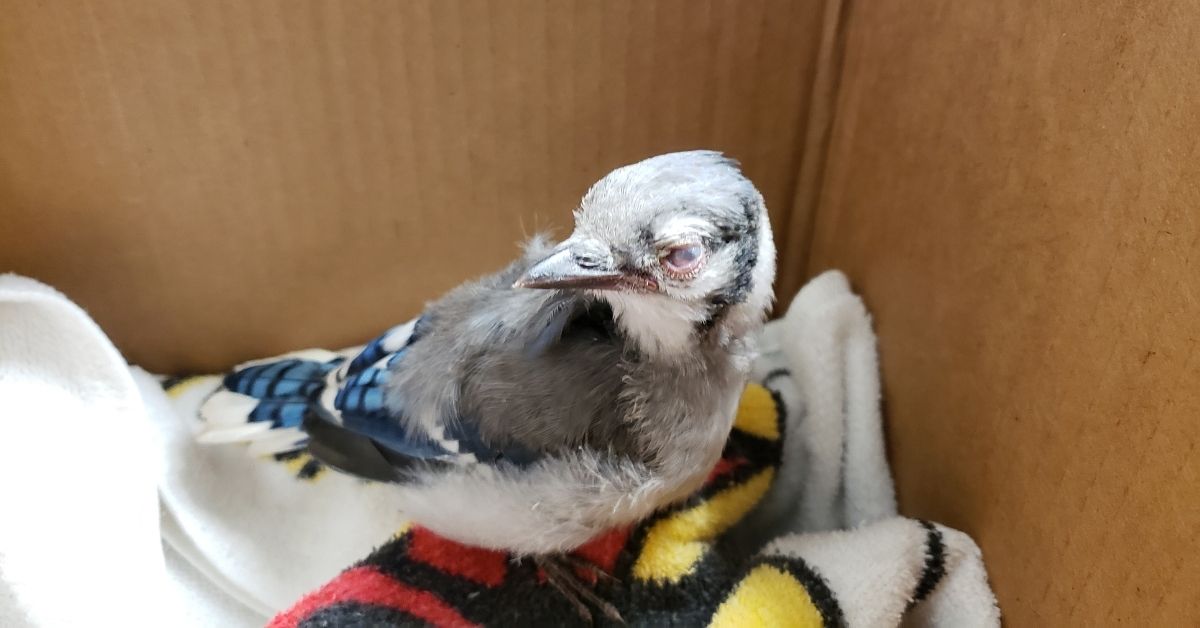
A sick blue jay found in the Washington, D.C., area.
By Dr. Megan Kirchgessner, DWR
Photos by Belinda Burwell, DVM
In late May, wildlife managers in Washington D.C., Maryland, Virginia, West Virginia, and Kentucky began receiving reports of sick and dying birds with eye swelling and crusty discharge, as well as neurological signs. More recently, additional reports have been received from Delaware, New Jersey, Pennsylvania, Ohio, and Indiana. While the majority of affected birds are reported to be fledgling common grackles, blue jays, European starlings, and American robins, other species of songbirds have been reported as well. No definitive cause(s) of illness or death have been determined at this time. No human health or domestic livestock and poultry issues have been reported.
The Virginia Department of Wildlife Resources (DWR) has been monitoring the extent of the event in the Commonwealth since late May. The Virginia areas affected by the mortality event include the following counties and cities: Alexandria, Arlington, Clarke, Fairfax, Falls Church, Fauquier, Frederick, Loudoun, Manassas, Prince William, Shenandoah, Warren, and Winchester. Between May 23 and June 30, DWR received over 1,400 reports of sick or dying birds from the affected areas. Approximately 450 of the reported cases described eye issues and/or neurological signs.
The natural resource management agencies in the affected states and the District of Columbia, along with the National Park Service, are continuing to work with diagnostic laboratories to investigate the cause(s) of this event. Those laboratories include the USGS National Wildlife Health Center, the University of Georgia Southeastern Cooperative Wildlife Disease Study, the University of Pennsylvania Wildlife Futures Program, and the Indiana Animal Disease Diagnostic Laboratory.
The following infectious agents have not been detected in any birds tested, based on results received to date: Salmonella and Chlamydia (bacterial pathogens); avian influenza virus, West Nile virus and other flaviviruses, Newcastle disease virus and other paramyxoviruses, herpesviruses and poxviruses; and Trichomonas parasites. Additional microbiology, virology, parasitology, and toxicology diagnostic testing is ongoing.
Birds congregating at bird feeders and bird baths can transmit diseases to one another. Therefore, the state and District agencies recommend the following standard precautions:- Cease feeding birds in the affected areas until this wildlife morbidity/mortality event subsides;
- Clean feeders and bird baths with a 10% bleach solution (one part bleach mixed with nine parts water), rinse with water, and allow to air dry;
- Avoid handling birds unless necessary. If you do handle them wear disposable gloves. If picking up a dead bird, place an inverted plastic bag over your hand to avoid direct contact with the bird; and
- Keep pets (including pet birds) away from sick or dead wild birds as a standard precaution.
- If at any time you find multiple dead birds in your yard over a short period of time, regardless of whether or not there is an ongoing bird mortality event, it is prudent to clean feeders and bird baths with a 10% bleach solution.
If you encounter sick or dead birds, in Virginia, please submit an event report. To dispose of dead birds, place in a plastic bag, seal, and discard with household trash or alternatively bury them deeply. DWR will alert the public when the mortality event has concluded and bird feeding can be resumed in the affected areas. Additional information will be shared as diagnostic results are received.- JULY 6, 2021
Leave a comment:
-
UPDATE: NWHC and partners continue investigating DC area morbidity-mortality event
Release Date: JULY 2, 2021
In late May, wildlife managers in Washington D.C., Maryland, Virginia, West Virginia, and Kentucky began receiving reports of sick and dying birds with eye swelling and crusty discharge, as well as neurological signs.
More recently, additional reports have been received from Delaware, New Jersey, Pennsylvania, Ohio, and Indiana. While the majority of affected birds are reported to be fledgling common grackles, blue jays, European starlings, and American robins, other species of songbirds have been reported as well. No definitive cause(s) of illness or death have been determined at this time. No human health or domestic livestock and poultry issues have been reported.
The natural resource management agencies in the affected states and the District of Columbia, along with the National Park Service, are continuing to work with diagnostic laboratories to investigate the cause(s) of this event. Those laboratories include the USGS National Wildlife Health Center, the University of Georgia Southeastern Cooperative Wildlife Disease Study, the University of Pennsylvania Wildlife Futures Program, and the Indiana Animal Disease Diagnostic Laboratory.
The following pathogens have not been detected in any birds tested, based on results received to date: Salmonella and Chlamydia (bacterial pathogens); avian influenza virus, West Nile virus and other flaviviruses, Newcastle disease virus and other paramyxoviruses, herpesviruses and poxviruses; and Trichomonas parasites. Transmission electron microscopy and additional diagnostic tests, including microbiology, virology, parasitology, and toxicology are ongoing.
Birds congregating at bird feeders and bird baths can transmit diseases to one another. Therefore, the state and District agencies recommend the following standard precautions:- Cease feeding birds until this wildlife morbidity/mortality event subsides;
- Clean feeders and bird baths with a 10% bleach solution (one part bleach mixed with nine parts water), rinse with water, and allow to air dry;
- Avoid handling birds unless necessary. If you do handle them wear disposable gloves. If picking up a dead bird, place an inverted plastic bag over your hand to avoid direct contact with the bird; and
- Keep pets (including pet birds) away from sick or dead wild birds as a standard precaution.
If you encounter sick or dead birds, please contact your state or District wildlife conservation agency for further instructions and to help them track this event. To dispose of dead birds, place in a plastic bag, seal, and discard with household trash or alternatively bury them deeply. Additional information will be shared as diagnostic results are received.
Leave a comment:
-
Indiana Department of Natural Resources
...
Songbird Deaths
In late May, DNR started receiving reports of sick and dying songbirds from Monroe County with neurological signs, eye swelling, and crusty discharge around the eyes.
Reports of sick and dying birds now include 50 counties, including: Allen, Bartholomew, Benton, Boone, Brown, Carroll, Cass, Clark, Clinton, Decatur, Delaware, Elkhart, Fayette, Floyd, Gibson, Greene, Hamilton, Hancock, Harrison, Hendricks, Henry, Howard, Jackson, Jasper, Jefferson, Johnson, Kosciusko, LaGrange, Lake, LaPorte, Lawrence, Madison, Marion, Monroe, Morgan, Newton, Ohio, Orange, Parke, Porter, Pulaski, Putnam, Shelby, Starke, St. Joseph, Tippecanoe, Union, Vanderburgh, Washington, Whitley..
The following species are principally affected: blue jay, American robin, common grackle, starling, northern cardinal, brown-headed cowbird.
DNR staff have collected samples and submitted them to the Indiana Animal Disease Diagnostic Laboratory. Final laboratory diagnostic results are pending – the cause or transmission is currently unknown and still under investigation.
All birds have tested negative for avian influenza and West Nile virus.
As the investigation continues, the DNR recommends all Hoosiers remove their birdfeeders, including those for hummingbirds, statewide.
...
Page updated 6/28/2021
...
------------------------------------------------------
Scientists Investigate Mysterious Songbird Deaths in Delaware, Several Other States and D.C. Area
Department of Natural Resources and Environmental Control | Division of Fish and Wildlife | Featured Posts | Date Posted:
Wednesday, June 30, 2021
...
State and federal wildlife experts and wildlife rehabilitators are investigating reports in at least six mid-Atlantic and central states, including Delaware, of sick and dying songbirds stricken by an unknown disorder characterized by swollen eyes with crusty discharge, as well as neurological signs such as erratic flight and stumbling. The Department of Natural Resources and Environmental Control has observed similar symptoms in Delaware’s avian population and more than 50 dead birds have been reported.
Juvenile birds appear to be more affected than adults, with European starlings, blue jays and common grackles as the species most associated with the debilitating event. Investigating agencies including DNREC are working cooperatively with animal health laboratories to find what’s behind this event, with Delaware’s samples sent to the Pennsylvania Animal Diagnostic Laboratory in New Bolton Center, Pa., but no definitive cause has been identified to date.
...
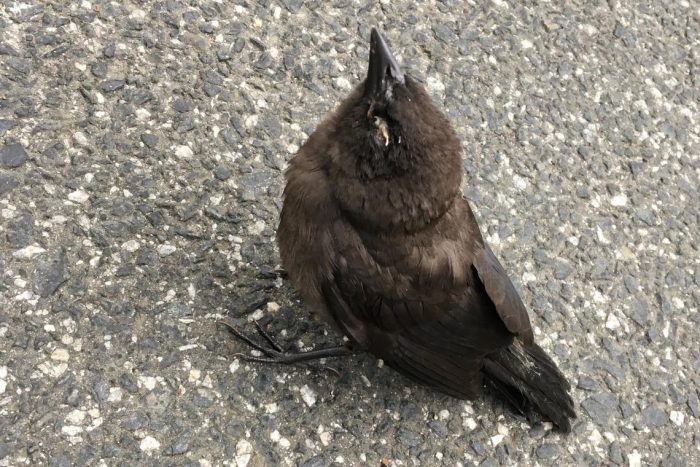 State and federal wildlife experts and wildlife rehabilitators are investigating reports of sick and dying songbirds stricken by an unknown disorder.
State and federal wildlife experts and wildlife rehabilitators are investigating reports of sick and dying songbirds stricken by an unknown disorder.
-------------------------------------------------------
OHIO DEPARTMENT OF NATURAL RESOURCES
...
BIRD DISEASE REPORTING
Recently, it has been observed that songbirds in Ohio are being affected by a disease. The primary species affected at this time are blue jays, common grackles, European starlings, American robins, and house sparrows. Ohio counties experiencing the bulk of the outbreak so far include Brown, Butler, Clark, Clermont, Delaware, Franklin, Greene, Hamilton, Montgomery, and Warren counties.
While we do not have an update on what is currently causing the disease, the ODNR Division of Wildlife advises that people please stop feeding birds, and take down and clean bird feeders and birdbaths with 10% bleach solution, particularly if they are seeing sick/dead birds in their area (as recommended by USGS). Doing these things can help slow the spread of the disease.
...
--------------------------------------------------------
Pennsylvania Game Commission
...
Songbird Mortality Event
Nestling and fledgling songbirds – mainly blue jays, starlings, and common grackles, but also robins and cardinals – have been found with ocular and neurologic issues, and in some cases these birds have been found dead in large numbers. Cases have been reported from TN, KY, VA, WV, MD, DE, IN, OH, FL, and recently from southeast PA (Nottingham, in Chester County).
The Pennsylvania Game Commission is recommending that people cease feeding birds until this event is resolved. There is no official moratorium.
What You Can Do
• Report occurrences online: https://www.vet.upenn.edu/research/c...-program.Opens In A New Window
• Cease feeding birds until this wildlife mortality event has concluded
• Clean feeders and bird baths with a 10% bleach solution
• Avoid handling birds, but wear disposable gloves if handling is necessary
• Keep pets away from sick or dead birds as a standard precaution
...
Leave a comment:
-
DNR recommends removal of birdfeeders statewide
Friday, June 25, 2021

The Indiana DNR has received reports of sick and dying songbirds from 15 counties statewide. As the investigation continues, the DNR recommends all Hoosiers remove their birdfeeders statewide.
The 15 counties are Clark, Delaware, Hamilton, Jackson, Jefferson, Johnson, LaGrange, Lake, Marion, Monroe, Newton, St. Joseph, Union, Washington, and Whitley.
DNR is working with the Indiana Animal Disease Diagnostic Laboratory (IN ADDL) and the USGS National Wildlife Health Center to determine the birds’ cause of death.
The affected songbirds showed neurological signs of illness as well as eye swelling and crusty discharge.
Several samples have been sent to IN ADDL. All bird samples submitted have tested negative for avian influenza and West Nile virus. Final laboratory diagnostic results are pending.
The following steps are recommended statewide:
• Use the DNR sick/dead wildlife reporting tool at on.IN.gov/sickwildlife to alert DNR staff.
• Stop feeding birds until the mortality event has concluded.
• Clean feeders and baths with a 10% bleach solution.
• Avoid handling birds. If you need to handle birds, wear disposable gloves.
• When removing dead birds, wear disposable gloves and place birds and gloves in a sealable plastic bag to dispose with household trash.
• Keep pets away from sick or dead birds as a precaution.
Additional information will be shared when final diagnostic results are received.
For updates, visit on.IN.gov/songbirddeaths
 The Indiana DNR has received reports of sick and dying songbirds from 15 counties statewide. As the investigation continues, the DNR recommends all Hoosiers remove their birdfeeders statewide. The 15 counties are Clark, Delaware, Hamilton, Jackson, Jefferson, Johnson, LaGrange, Lake, Marion, Monroe, Newton, St. Joseph, Union, Washington, and Whitley. DNR is working with the Indiana Animal Disease Diagnostic Laboratory (IN ADDL) and the USGS National Wildlife Health Center to determine the birds’ cause of death. The affected songbirds showed neurological signs of illness as well as eye swelling and crusty discharge. Several samples have been sent to IN ADDL. All bird samples submitted have tested negative for avian influenza and West Nile virus. Final laboratory diagnostic results are pending. The following steps are recommended statewide: • Use the DNR sick/dead wildlife reporting tool at on.IN.gov/sickwildlife to alert DNR staff. • Stop feeding birds until the mortality event has concluded. • Clean feeders and baths with a 10% bleach solution. • Avoid handling birds. If you need to handle birds, wear disposable gloves. • When removing dead birds, wear disposable gloves and place birds and gloves in a sealable plastic bag to dispose with household trash. • Keep pets away from sick or dead birds as a precaution. Additional information will be shared when final diagnostic results are received. For updates, visit on.IN.gov/songbirddeaths
The Indiana DNR has received reports of sick and dying songbirds from 15 counties statewide. As the investigation continues, the DNR recommends all Hoosiers remove their birdfeeders statewide. The 15 counties are Clark, Delaware, Hamilton, Jackson, Jefferson, Johnson, LaGrange, Lake, Marion, Monroe, Newton, St. Joseph, Union, Washington, and Whitley. DNR is working with the Indiana Animal Disease Diagnostic Laboratory (IN ADDL) and the USGS National Wildlife Health Center to determine the birds’ cause of death. The affected songbirds showed neurological signs of illness as well as eye swelling and crusty discharge. Several samples have been sent to IN ADDL. All bird samples submitted have tested negative for avian influenza and West Nile virus. Final laboratory diagnostic results are pending. The following steps are recommended statewide: • Use the DNR sick/dead wildlife reporting tool at on.IN.gov/sickwildlife to alert DNR staff. • Stop feeding birds until the mortality event has concluded. • Clean feeders and baths with a 10% bleach solution. • Avoid handling birds. If you need to handle birds, wear disposable gloves. • When removing dead birds, wear disposable gloves and place birds and gloves in a sealable plastic bag to dispose with household trash. • Keep pets away from sick or dead birds as a precaution. Additional information will be shared when final diagnostic results are received. For updates, visit on.IN.gov/songbirddeaths
Leave a comment:
-
Scientists don't know why hundreds of birds are getting sick and dying across the U.S.
...
June 22, 2021, 1:28 PM CST
By Deon J. Hampton
...
Some theories about what's causing the birds to become sick and die include a widespread infectious disease, the cicada outbreak and pesticides, said Laura Kearns, a wildlife biologist with the Ohio Division of Wildlife. She said hundreds of birds have been found dead in the state.
Indiana wildlife officials said there have been suspicious deaths of blue jays, robins, northern cardinals and brown-headed cowbirds in five counties. James Brindle, spokesman for the state's Department of Natural Resources, said birds there have tested negative for avian influenza and West Nile virus.
The bird specimens from Kentucky were sent to the Southeastern Cooperative Wildlife Disease Study at the University of Georgia for testing.
“This is probably a new issue,” Slankard said of what’s possibly causing the deaths.
...
---------------------------------------------------------------
KY Receives Hundreds Of Reports Of Mystery Illness Affecting Songbirds
By Ryan Van Velzer
ENVIRONMENTJune 23, 2021
...
“Basically, in our meeting, it was like, ‘What is everybody seeing?’ and we haven’t come up with one definitive answer and so we are exploring all possibilities,” said Dr. Christine Casey, wildlife veterinarian with the Kentucky Department of Fish and Wildlife Resources.
Last week Kentucky wildlife officials asked residents in Jefferson, Boone and Kenton counties to take down bird feeders until further notice to help curb the spread. They also opened an online reporting tool that has since received around 700 reports of sick and dying birds, mostly in Central and Northern Kentucky. Officials are now sorting through those reports.
...
Casey says that the reports indicate blue jays, common grackles and European starlings are the most commonly affected. Juveniles are affected more often than adults, and there’s no indication the disease has spread to livestock like chickens.
...
One theory is that the illness might be connected to this year’s emergence of Brood X cicadas. Casey said wildlife officials in both Kentucky and Virginia have submitted cicadas found near dead birds for testing.
“At this point, I mean, all possibilities are being explored. There’s been weirder things that have happened so we don’t want to ignore something that could be a possibility,” Casey said.
The illness appears to be distinct from the salmonella outbreaks that occurred earlier this year.
...
Leave a comment:
-
Numerous reports of dead birds across Ohio due to 'mysterious' illness
...
Author: Ross Caruso
Published: 6:29 PM EDT June 21, 2021
Updated: 7:05 PM EDT June 21, 2021
COLUMBUS, Ohio — ...
"We've been getting these reports for the past couple weeks," said Gary Comer, District Wildlife Supervisor District 1, ODNR Division of Wildlife.
"There are neurological signs of their necks bending and flopping over to the side and also a lack of clearness or discharge from the eyes from conjunctivitis."
...
"We’re assuming that it’s probably viral but we don’t know that for a fact."
Right now there is no treatment available for these sick birds.
...
Comer said that the most common birds that have been reported with this disease are Crows, Blue Jays, Grackles, European Starlings and a couple of reports of Mourning Doves.
...
Comer recommends keeping your kids and pets away from these sick birds and that if you do need to remove them that you are wearing gloves and are properly disposed of.
...
Leave a comment:
-
BIRD MORTALITY EVENT
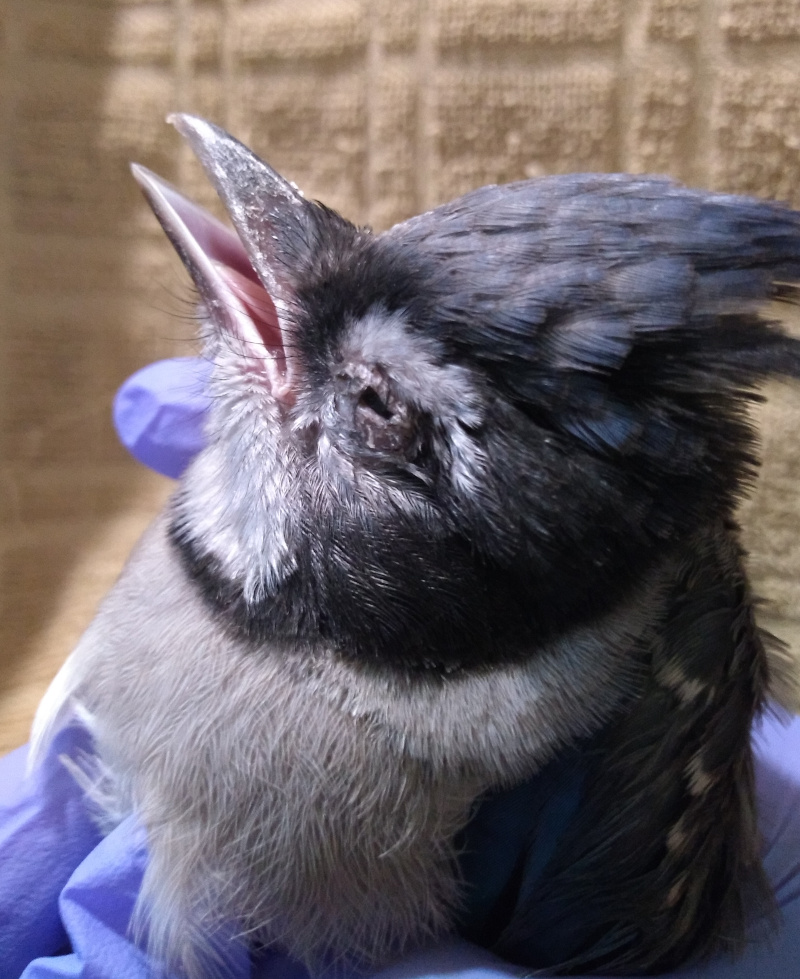
Image Provided by Ginger Rood
...
In late May, the Kentucky Department of Fish and Wildlife Resources began receiving reports of sick and dying birds with eye swelling and crusty discharge, as well as neurological signs. Wildlife agencies in Indiana, Maryland, Ohio, Virginia, Washington, D.C. and West Virginia have reported similar problems.
State wildlife agencies are working with diagnostic laboratories to investigate the cause of mortality. Kentucky Fish and Wildlife has sent more than 20 samples for lab testing to the Southeastern Cooperative Wildlife Disease Study at the University of Georgia. More results are pending, but no definitive cause of death has been identified at this time.
In Kentucky, reports of sick and dying birds have come from Jefferson, Kenton and Boone counties. Thus far, species affected have been blue jays, common grackles and European starlings, but other species may be affected as well.
Birds congregating at feeders and baths can transmit disease to one another. Therefore, Kentucky Fish and Wildlife recommends the public follow these guidelines:
In Jefferson, Boone and Kenton Counties:- Cease feeding birds until further notice (when this issue has been resolved);
- Clean feeders and bird baths with a 10 percent bleach solution immediately, then weekly thereafter;
- Avoid handling birds, but wear disposable gloves if handling is necessary; and
- Keep pets away from sick or dead birds as a standard precaution.
www.research.net/r/2021KYSickBirdReports
If you must remove dead birds, place them in a sealable plastic bag and dispose of the bag in a secured outdoor trash receptacle.
Kentucky Fish and Wildlife will post additional information on its Wildlife Health and Disease webpage and social media channels as diagnostic results become available.
https://fw.ky.gov/Wildlife/Pages/Bir...ity-Event.aspx
Leave a comment:






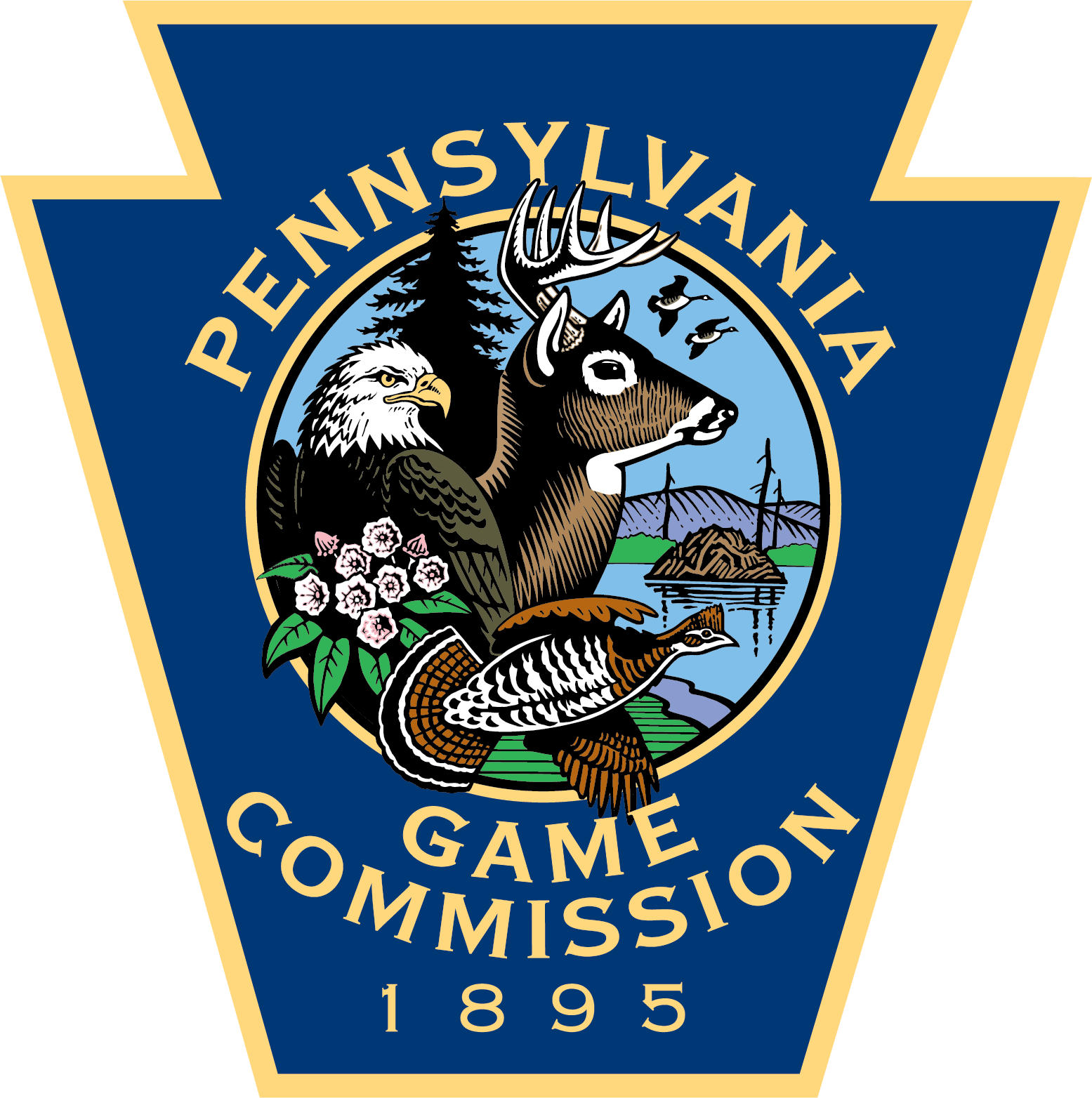
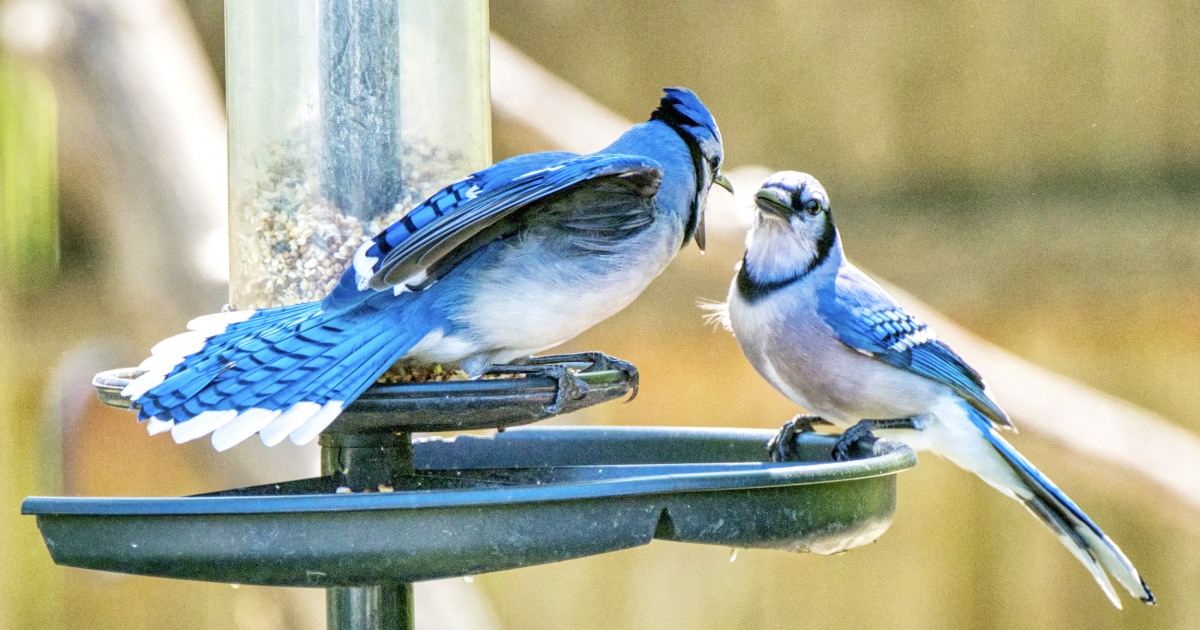

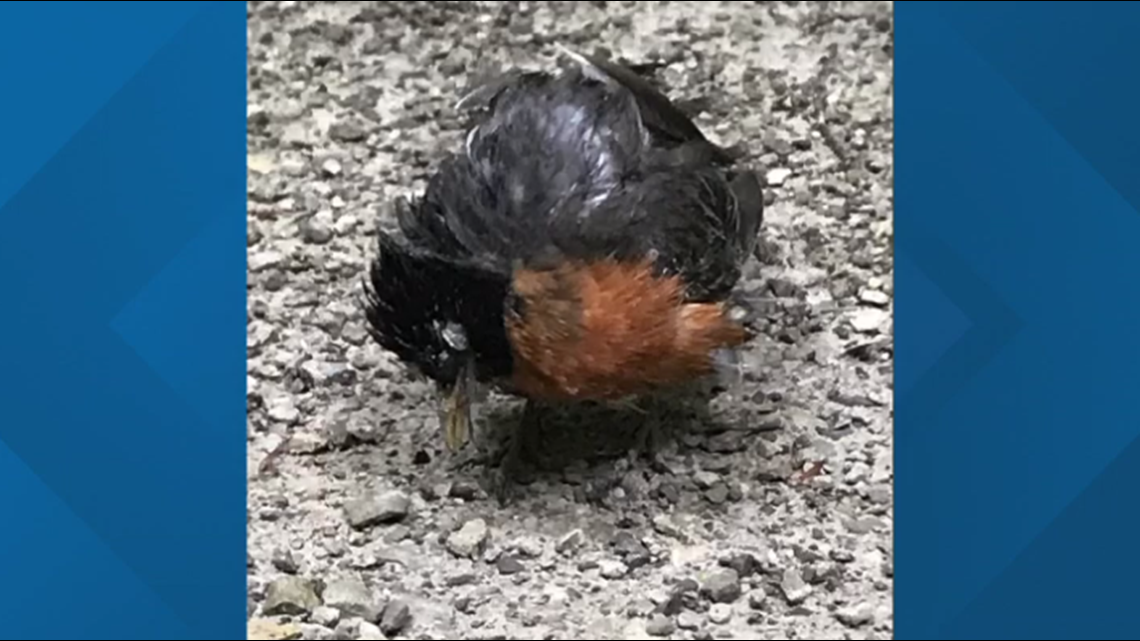
Leave a comment: